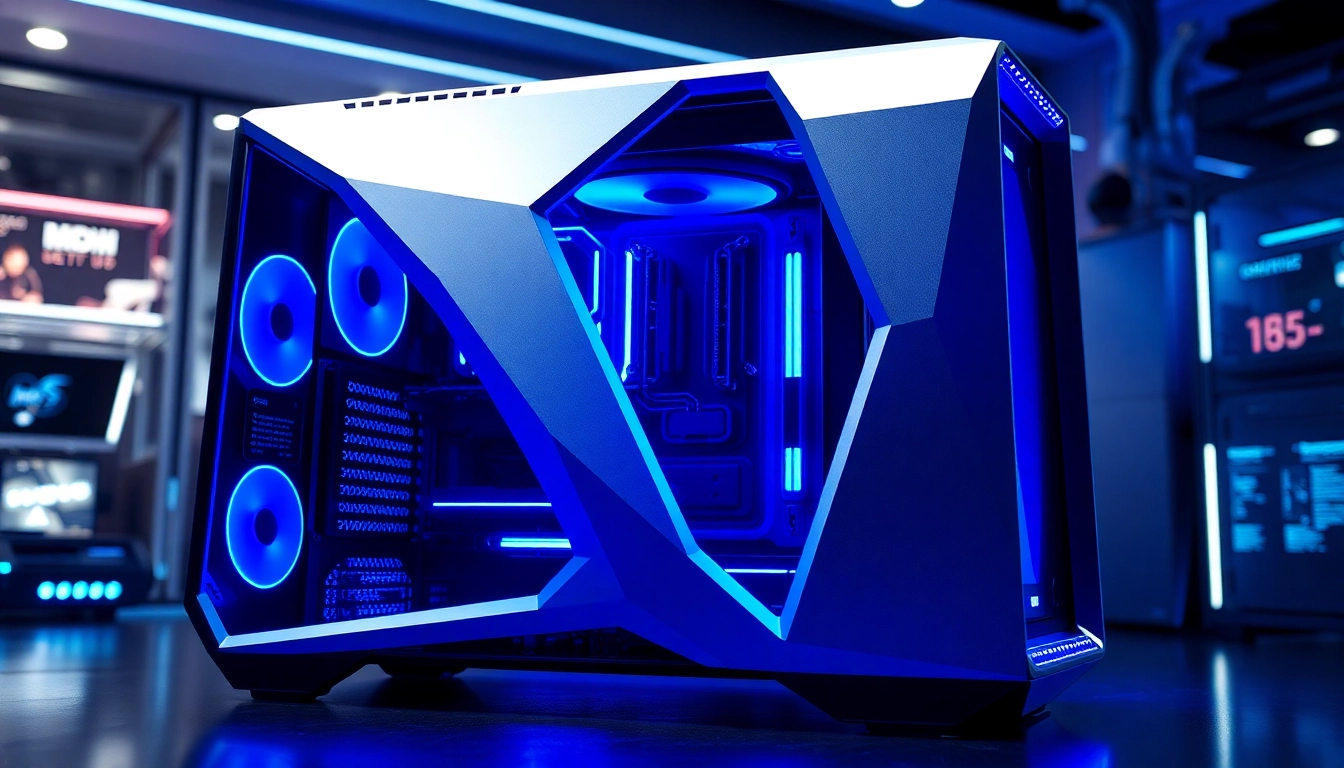Understanding PC Cases
What is a PC Case?
A PC case, also known as a chassis or cabinet, serves as the housing for the components of a computer. This protective enclosure is critical for keeping hardware secure and functioning optimally. Inside a PC case, you’ll find essential components such as the motherboard, power supply, hard drives, optical drives, and cooling systems. The design and construction of a PC case can vary significantly based on functionality, aesthetics, and user preferences.
Importance of Choosing the Right PC CASE Supplier
Selecting the right PC CASE Supplier is integral in ensuring the quality and compatibility of your build. A reputable supplier provides not only a diverse range of chassis options but also critical support in terms of product availability, after-sales service, and warranty. Premium suppliers often source their models with features that enhance both performance, such as proper airflow, and aesthetics, such as RGB lighting. Your supplier’s reliability can also affect the longevity of your components, as poor-quality cases may not protect adequately against dust, heat, or physical damage.
Different Types of PC Cases Explained
When diving into the world of PC cases, it’s essential to understand the different types available so that you can make an informed choice. The main varieties include:
- Full Tower Cases: These are ideal for high-performance builds, providing ample space for additional components and superior cooling options.
- Mid Tower Cases: A popular choice for many builders, mid-tower cases offer balance in size, capacity, and features.
- Mini Tower Cases: Smaller than mid-tower cases, these are suited for more compact builds, often catering to HTPC (Home Theater PC) setups.
- Micro ATX Cases: Designed for micro ATX motherboards, these cases cater to more budget-friendly and space-conscious builds.
- SFF (Small Form Factor) Cases: Even smaller than micro ATX cases, SFF cases are perfect for ultra-compact PC builds, often used for gaming on the go or minimalistic setups.
Features to Consider in a PC Case
Size and Form Factor Variations
The size of the PC case is one of the most critical factors to consider when building a desktop. The form factor determines how much space you have for other components and how well your case will fit within your workspace. Ensure that the case size matches the motherboard size, as ATX motherboards won’t fit in mini tower cases. Furthermore, large cases often provide greater airflow, allowing ample cooling solutions which can greatly enhance system performance.
Cooling Solutions in PC Cases
Effective cooling is vital for the performance and longevity of your PC. When selecting a case, consider its cooling solution capabilities, including:
- Fan Mounting Options: Check for the number of fans that can be installed and where they can be placed for optimal airflow.
- Radiator Support: For liquid cooling solutions, ensure the case can accommodate the necessary radiators, which come in various sizes.
- Airflow Design: Cases that allow for unobstructed airflow may provide better cooling efficiency, often featuring mesh panels or strategically placed fan slots.
Design Aesthetics and Functionality
Aesthetics play a significant role in a PC case’s appeal, especially for gamers and enthusiasts who value visual presentation as much as performance. Design elements might include tempered glass panels to showcase internal components, customizable RGB lighting, and various color options. Yet, while style is important, it should not come at the expense of functionality. Ensure that your case also has ample cable management solutions to keep your build tidy and organized.
Top PC Case Brands
Leading PC CASE Suppliers to Know
Several brands have established themselves as industry leaders in the PC case market. They are known for their reliability, innovation, and superior features. Some notable suppliers include:
- Corsair: A well-known name offering a selection of stylish and functional cases, particularly for high-performance gaming rigs.
- Lian Li: Renowned for aluminum cases with an elegant aesthetic and premium build quality.
- Thermaltake: Offers gaming-oriented cases with features tailored for airflow and RGB aesthetics.
- NZXT: Known for their minimalist designs and excellent cable management solutions.
- Antec: Provides a mix of budget-friendly and performance-oriented cases, offering options for gamers and builders alike.
Comparing Popular Brands
When comparing popular brands, consider factors such as build quality, customer reviews, and feature sets. Brands like Corsair and Lian Li often rate highly in terms of cooling efficiency and aesthetic design, while Thermaltake focuses on RGB capability and customization. Analyze user reviews to see how these products perform in real-world scenarios, paying attention to common praises and complaints.
User Reviews and Recommendations
Feedback from existing users can provide invaluable insights when selecting a PC case. Online platforms, including user forums, retail websites, and tech review sites, often highlight the pros and cons of specific models. Look for reviews that emphasize ease of setup, cooling performance, and overall user satisfaction to guide your decision-making.
How to Build a PC with the Right Case
Tools Needed for Assembly
Before you start assembling your PC, ensure you have the following tools on hand:
- Phillips Screwdriver: Essential for attaching hardware inside your case.
- Anti-Static Wristband: To prevent static electricity from damaging sensitive components.
- Cable Ties: Helpful for managing and organizing cables within the case.
- Thermal Paste: Required if you are installing a CPU cooler separate from the CPU (if not pre-applied).
Step-by-Step Guide to Building
Assembling a PC involves several crucial steps:
- Preparation: Ensure your workspace is clean and you have all components ready (motherboard, CPU, RAM, GPU, storage, PSU, etc.).
- Install Power Supply: Start by placing the PSU inside the case and securing it with screws.
- Prepare the Motherboard: Install the CPU and RAM on the motherboard before placing it in the case.
- Mount the Motherboard: Secure the motherboard to the case using standoffs.
- Install Other Components: Place your GPU, storage drives, and any additional components as necessary.
- Cable Management: Connect all necessary cables, making sure to route them for optimal airflow and aesthetics.
- Cooling Solutions: Ensure fans and radiators are properly positioned and connected.
- Power On: Once everything is connected, power on your PC and check for any issues.
Common Mistakes and How to Avoid Them
Building a PC can be daunting, and common mistakes often occur, including:
- Incompatibility Issues: Double-check compatibility between components before purchase and assembly.
- Poor Cable Management: Plan cable routes during the build to maintain airflow and improve aesthetics.
- Missing Components: Make a checklist of all necessary parts to avoid forgetting key components.
By taking your time and carefully following each step, you can ensure a successful build without the hassle of encountering these common pitfalls.
Where to Buy Quality PC Cases
Top Online Retailers for PC Cases
When looking for the perfect PC case, consider purchasing from renowned online retailers, such as:
- Newegg: Offers a wide selection of cases, often at competitive prices with frequent sales.
- Amazon: Features a vast range of products, including user reviews that can help inform your purchase.
- Micro Center: A go-to for tech enthusiasts, providing a variety of cases both online and in-store.
Local Stores and Showrooms
If you prefer seeing products in person, consider visiting local electronics or computer hardware stores. Showrooms allow you to physically assess the case’s build quality, size, and design. Additionally, local retailers can provide on-site assistance, which can be beneficial for first-time builders.
Tips for Getting the Best Deals
To ensure you get the best deal on your new PC case, consider the following tips:
- Sign Up for Newsletters: Many retailers provide exclusive discounts and announcements via email.
- Take Advantage of Seasonal Sales: Major holidays often bring significant discounts on PC components.
- Compare Prices: Use price comparison websites to find the best deals available on the market.



